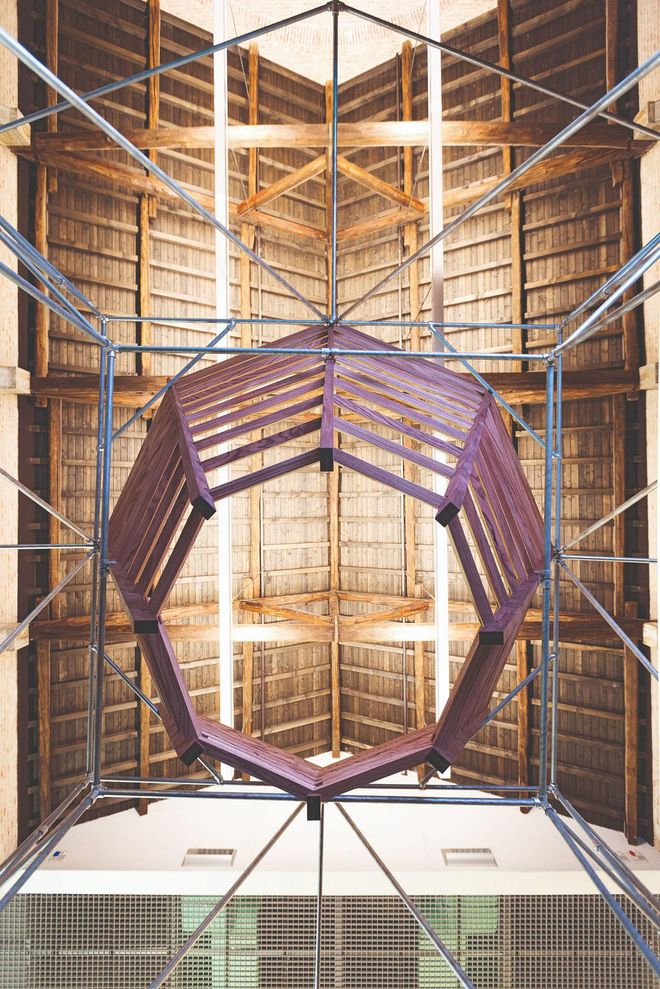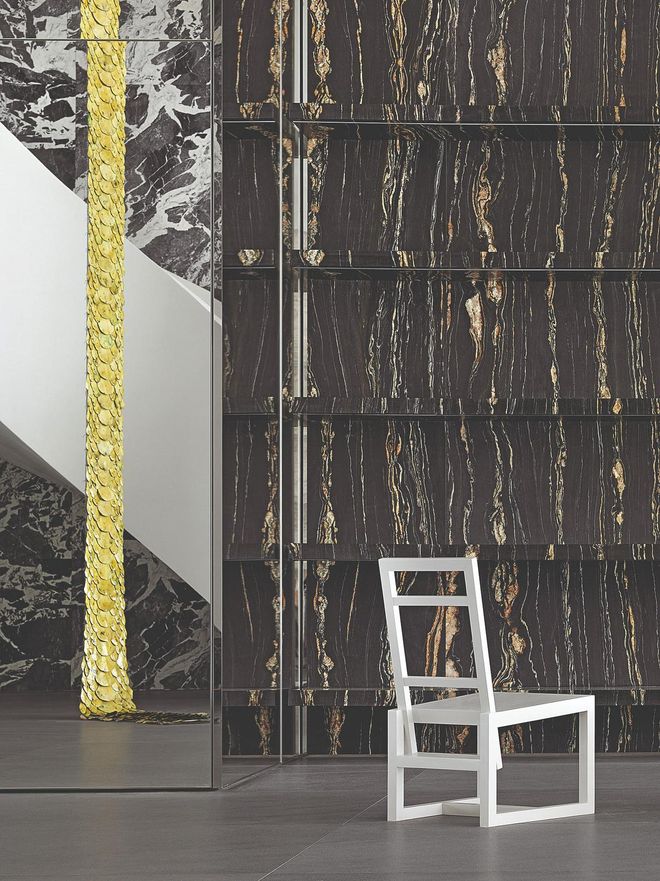Why Installation Art Is At The Forefront Of Fashion’s Ongoing Intersection With Art
At the forefront of fashion’s ongoing intersection with the art world is installation, a creative form that offers connoisseurs a different experience


COS partnered with French architect Arthur Mamou-Mani to create "Conifera", an installation of 3D-printed bioplastic bricks, for this year's Salone del Mobile.Photo: Courtesy
COS x Mamou
The art world and fashion have long been bedfellows—sometimes literally, as in the case of Coco Chanel, who was romantically involved with composer Igor Stravinsky and counted artists such as Pablo Picasso among her friends. Her chief rival, Elsa Schiaparelli, was a fan of the Surrealists, most famously collaborating with Salvador Dali on her iconic Lobster dress.
Today, the relationships between fashion designers and artists are alive and well, though both sides of the equation have changed greatly. Fashion is now a breakneck industry dominated by the notion of availability, with fashion shows on demand and clothes, bags and accessories ready to be shopped and shipped at a click. The art front has seen the emergence of a $63 billion market fuelled by ultra rich collectors and cutthroat gallerists.
These days, the two cross over so routinely and so often, that the thrill of such collaborations now only provoke mild interest. Gone are the days when the idea of Yayoi Kusama’s or Takashi Murakami’s work on Louis Vuitton handbags could surprise and subvert. And when even High Street brands like H&M are getting in on the action, the glow inevitably dulls.
The alternative, as it turns out, is installation art. The form, a relatively new development in contemporary art, is striking because the works leave the canvas, screen, or page, and find themselves in a 3D space. Liveable, breathable art, as it were. In gallery or museum settings, you can often walk around and into the installation—which gives visitors a new way to regard, experience and appreciate art. In a fashion context, installation art helps serve a purpose loftier than the hawking of a product. Because you can’t sell an installation, there is a layer of believable integrity.
This can be observed most regularly at the annual Salone del Mobile design trade fair, where increasingly, fashion brands have staked out spaces. For the 2019 edition, COS teamed up with French architect Arthur Mamou-Mani to create “Conifera”, an installation of 3D-printed bioplastics at the Palazzo Isimbardi. Mamou-Mani used the renewable material to create pyramidal bricks which were arranged around the space. The bricks used different colours, textures and finishes to correspond to the interior and exterior spaces it occupied. “‘Conifera’ blends the digital with the physical world while addressing sustainability through the use of compostable bio-plastic, produced and 3D-printed locally,” says Mamou-Mani. “It is a dialogue between technology and craft, between man-made and natural, and between monumentality and lightness.” The brand maintains a assured sense of self, finding supplementary collaborators to create extensions of its rigorously studied minimalism. An evolution of the COS aesthetic, in other words, through different mediums. Skeptics might call it brand-building.
Related article: 10 Best Travel Destinations For Art Lovers

For its "No_Code Shelter: Stories of Contemporary Life", Tod's teamed up with the team at Studio Andrea CaputoPhoto: Courtesy
Tods
For an older heritage brand like Tod’s, finding new methods of artistic collaboration is also key. In 2018, Tod’s launched No_Code, a project arm meant to explore and push the boundaries of the brand—a sort of fashion think tank. At Salone del Mobile, that arm worked with the Italian practice Studio Andrea Caputo on “No_Code Shelter: Stories of Contemporary Life”. The partnership resulted in a range of experiential spaces inspired by human habitats: From old-fashioned igloos, yurts and tents, to futuristic huts girded with welded metal poles. Television screens were installed inside these spaces, showing video conversations with eight international creatives.
It was an oblique method of studying changes in lifestyle, meant to echo Tod’s ethos of marrying technology and traditional craftsmanship. The project explored how we live our lives and the ways we might better it. Walking through the Shelter show, you were not presented with product but ideas and a smattering of philosophy instead.
Raf Simons is another designer who effortlessly merges the two lanes of art and fashion. His ongoing project with Kvadrat on interior and upholstery textiles was contextualised this year in a manufactured neighbourhood. Titled “No Man’s Land”, the space was outfitted as a corporeal expression of the collaborators. It’s a natural medium, considering Simons was formally trained in industrial design before making the switch to fashion. The interior of “No Man’s Land” used prefab furniture from modernist designers and architects like Jean Prouvé and Le Corbusier—the kind of designers Simons would have studied in school. “It’s not a showroom, it’s an environment, a place of inspiration,” said Simons in an interview with The Guardian. “It’s so much more massive than anything we’ve done before.”
Related article: Tod's Unveils Its New It Bag: D-Styling

CELINE's Omotesando boutique in Tokyo features a chain-mail sculpture by Canadian visual artist Elaine Cameron Weir.Photo: Courtesy
Celine
That lived-and-experienced element might be why fashion is so drawn to installation art. As e-commerce takes over the physical experience of shopping, retailers and brands have kept up by crafting experiences worth making a trip for. Gucci and CELINE, for example, almost immediately revamped the interior designs of their boutiques worldwide to reflect their new creative visions: Nests of kitsch glam for the former, and sleek temples of marble and steel for the latter. The goal is to transport you into a world of their making.
That’s an idea central to Gentle Monster’s retail approach. The Korean eyewear brand remains one of the buzziest around because of its unique designs and collaborations with a host of brands and celebrities like Tilda Swinton and, most recently, Fendi. But the thing that keeps the customers coming? The stores themselves, which are designed around centrepiece works of art and make believe narratives. The newest one in town at Marina Bay Sands is named “The Data Addicts”, conceptualised around the overwhelming and obsessive nature of data in our lives and its ecological effects.
Related article: This 8-year-old Insta-icon Is The Perfect Model For Gentle Monster's First Kids Collection

A satellite dish installation at Gentle Monster's Marina Bay Sands store.Photo: Courtesy
Gentle Monsters
From that narrative, the brand’s project manager and spatial designer, Lee Jihee and Shim Somib respectively, spun a spatial post-apocalyptic metaphor. “The concept describes people who always seem obsessed and overwhelmed information they receive daily,” says the brand’s spokesman. “It is in line with Gentle Monster’s holistic message where the product design, the space design,and visual concepts are all under one overarching theme.”
It’s anyone’s guess how long installation art can keep itself free from consumerist association. Once designers fully catch on and employ it in the service of retail experience, its novelty and effect might wear off. Until then, best to just take in the view and enjoy it.